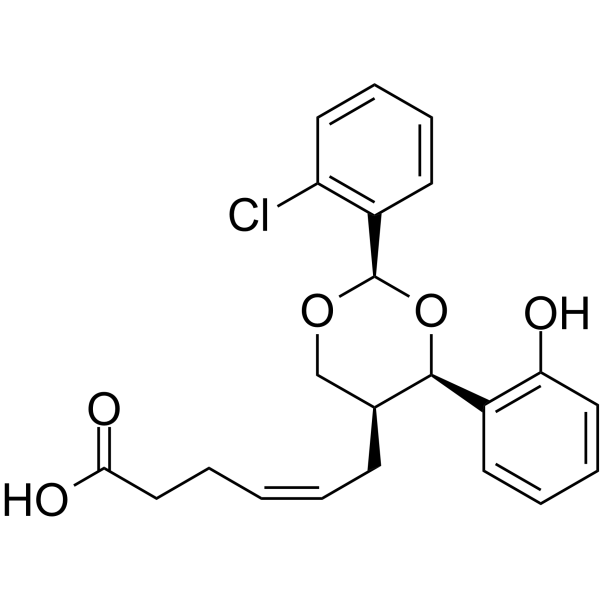
| 规格 | 价格 | |
|---|---|---|
| 500mg | ||
| 1g | ||
| Other Sizes |
| 靶点 |
TXA2R
|
|---|---|
| 体外研究 (In Vitro) |
报道了一种新型血栓素受体拮抗剂4(Z)-6-(2-氯苯基-4-邻羟基苯基-1,3-二氧杂环己烷-5-基)己烯酸(ICI 192605)的合成和药理学概述。化合物3具有竞争性和选择性,其pA2值在平滑肌制剂上为8.0+/-0.1(兔)和8.4+/-0.05(大鼠),在人血小板上为8.16+/-0.01[1]。
ICI 192605是一种高度选择性的TP受体阻断剂,pA2约为8(Brewster等人,1988;Brown等人,1990)。在本研究中,10-8M ICI 192605显著降低了8-iso-PGE2诱发的收缩,当该阻断剂的浓度增加10倍时,收缩消失(图3和图4),表明它们可能是通过TP受体引导的。[2] |
| 体内研究 (In Vivo) |
在Konzett-Rossler豚鼠模型中,以0.01mg/kg p.o的剂量证明了ICI 192605的体内活性。[1]
|
| 参考文献 |
|
| 其他信息 |
The synthesis and summary pharmacology of a novel thromboxane receptor antagonist 4(Z)-6-(2-o-chlorophenyl-4-o-hydroxyphenyl-1, 3-dioxan-cis-5-yl) hexenoic acid (3) is reported. Compound 3 was competitive and selective with pA2 values of 8.0 +/- 0.1 (rabbit) and 8.4 +/- 0.05 (rat) on smooth muscle preparations and 8.16 +/- 0.01 on human platelets. In vivo activity of 3 was demonstrated in a Konzett Rossler guinea pig model at 0.01 mg/kg p.o. [1]
We investigated the effects of five different isoprostanes (8-iso PGE1, 8-iso PGE2, 8-iso PGF1α, 8-iso PGF2α and 8-iso PGF2β) on vasomotor tone in human and porcine bronchial arterial tissues. In the human bronchial arteries, 8-iso PGE2 and 8-iso PGF2α evoked powerful constrictions (magnitudes several fold greater than the responses to high millimolar KCl) with negative log concentration causing 50% excitation (EC50) values of 6.8 and 6.5, respectively; 8-iso PGE1 was less potent (EC50 not calculated, since a clear peak contraction was not obtained), while the other isoprostanes were largely ineffective. In the porcine arteries, on the other hand, all three F-ring isoprostanes as well as 8-iso PGE2 evoked constrictor responses, although the peak magnitudes were approximately 50% of the KCl-evoked response; 8-iso PGE2 and 8-iso PGF2α were the most potent, with negative log EC50 values of 6.5. We next sought to characterize the signaling pathways underlying the vasoconstrictor responses to 8-iso PGE2, since this was the most potent of the isoprostanes we tested. These responses were largely reversed by the thromboxane A2-selective (TP) prostanoid receptor antagonist ICI 192605 (10−8 M; 4(Z)-6-[(2,4,5 cis)2-(2-chlorophenyl)-4-(2-hydroxy phenyl)1,3-dioxan-5-yl]hexenoic acid) as well as by the nonspecific tyrosine kinase inhibitor genistein (10−5 and 10−4 M), and were reversed approximately 50% by the Rho-kinase inhibitor Y27632 (10−5 M; (+)-(R)-trans-4-(1-aminoethyl)-N-(pyridyl) cyclohexanecarboxamide dihydrochloride). We conclude, therefore, that 8-iso PGE2 constricts bronchial vasculature through the activation of TP receptors, which in turn trigger tyrosine kinase and Rho-kinase activities, resulting in powerful vasoconstriction. These findings are highly relevant to lung transplantation and to exercise-induced asthma. [2] |
| 分子式 |
C22H23CLO5
|
|---|---|
| 分子量 |
402.87
|
| 精确质量 |
402.123
|
| 元素分析 |
C, 65.59; H, 5.75; Cl, 8.80; O, 19.86
|
| CAS号 |
117621-64-4
|
| PubChem CID |
6438399
|
| 外观&性状 |
Typically exists as solid at room temperature
|
| 密度 |
1.262 g/cm3
|
| 沸点 |
540.1ºC at 760 mmHg
|
| 闪点 |
280.4ºC
|
| 蒸汽压 |
1.7E-12mmHg at 25°C
|
| 折射率 |
1.583
|
| LogP |
5.259
|
| tPSA |
75.99
|
| 氢键供体(HBD)数目 |
2
|
| 氢键受体(HBA)数目 |
5
|
| 可旋转键数目(RBC) |
7
|
| 重原子数目 |
28
|
| 分子复杂度/Complexity |
525
|
| 定义原子立体中心数目 |
3
|
| SMILES |
OC(CC/C=C\C[C@H]1CO[C@@H](C2=CC=CC=C2Cl)O[C@H]1C1=CC=CC=C1O)=O
|
| InChi Key |
WHUIENZXNGAHQI-YGPRPMEGSA-N
|
| InChi Code |
InChI=1S/C22H23ClO5/c23-18-11-6-4-9-16(18)22-27-14-15(8-2-1-3-13-20(25)26)21(28-22)17-10-5-7-12-19(17)24/h1-2,4-7,9-12,15,21-22,24H,3,8,13-14H2,(H,25,26)/b2-1-/t15-,21+,22+/m0/s1
|
| 化学名 |
(Z)-6-[(2R,4R,5S)-2-(2-chlorophenyl)-4-(2-hydroxyphenyl)-1,3-dioxan-5-yl]hex-4-enoic acid
|
| 别名 |
ICI-192605 ; ICI192605; 117621-64-4; ICI 192605; 6-(2-(2-Chlorophenyl-4-hydroxyphenyl)-1,3-dioxan-5-yl)hexenoic acid; Ici-192605; (Z)-6-[(2R,4R,5S)-2-(2-chlorophenyl)-4-(2-hydroxyphenyl)-1,3-dioxan-5-yl]hex-4-enoic acid; ICI 192,605; FQ9418XA31; 4-Hexenoic acid, 6-(2-(2-chlorophenyl)-4-(2-hydroxyphenyl)-1,3-dioxan-5-yl)-, (2alpha,4alpha,5alpha(Z))-; ICI 192605
|
| HS Tariff Code |
2934.99.9001
|
| 存储方式 |
Powder -20°C 3 years 4°C 2 years In solvent -80°C 6 months -20°C 1 month |
| 运输条件 |
Room temperature (This product is stable at ambient temperature for a few days during ordinary shipping and time spent in Customs)
|
| 溶解度 (体外实验) |
May dissolve in DMSO (in most cases), if not, try other solvents such as H2O, Ethanol, or DMF with a minute amount of products to avoid loss of samples
|
|---|---|
| 溶解度 (体内实验) |
注意: 如下所列的是一些常用的体内动物实验溶解配方,主要用于溶解难溶或不溶于水的产品(水溶度<1 mg/mL)。 建议您先取少量样品进行尝试,如该配方可行,再根据实验需求增加样品量。
注射用配方
注射用配方1: DMSO : Tween 80: Saline = 10 : 5 : 85 (如: 100 μL DMSO → 50 μL Tween 80 → 850 μL Saline)(IP/IV/IM/SC等) *生理盐水/Saline的制备:将0.9g氯化钠/NaCl溶解在100 mL ddH ₂ O中,得到澄清溶液。 注射用配方 2: DMSO : PEG300 :Tween 80 : Saline = 10 : 40 : 5 : 45 (如: 100 μL DMSO → 400 μL PEG300 → 50 μL Tween 80 → 450 μL Saline) 注射用配方 3: DMSO : Corn oil = 10 : 90 (如: 100 μL DMSO → 900 μL Corn oil) 示例: 以注射用配方 3 (DMSO : Corn oil = 10 : 90) 为例说明, 如果要配制 1 mL 2.5 mg/mL的工作液, 您可以取 100 μL 25 mg/mL 澄清的 DMSO 储备液,加到 900 μL Corn oil/玉米油中, 混合均匀。 View More
注射用配方 4: DMSO : 20% SBE-β-CD in Saline = 10 : 90 [如:100 μL DMSO → 900 μL (20% SBE-β-CD in Saline)] 口服配方
口服配方 1: 悬浮于0.5% CMC Na (羧甲基纤维素钠) 口服配方 2: 悬浮于0.5% Carboxymethyl cellulose (羧甲基纤维素) 示例: 以口服配方 1 (悬浮于 0.5% CMC Na)为例说明, 如果要配制 100 mL 2.5 mg/mL 的工作液, 您可以先取0.5g CMC Na并将其溶解于100mL ddH2O中,得到0.5%CMC-Na澄清溶液;然后将250 mg待测化合物加到100 mL前述 0.5%CMC Na溶液中,得到悬浮液。 View More
口服配方 3: 溶解于 PEG400 (聚乙二醇400) 请根据您的实验动物和给药方式选择适当的溶解配方/方案: 1、请先配制澄清的储备液(如:用DMSO配置50 或 100 mg/mL母液(储备液)); 2、取适量母液,按从左到右的顺序依次添加助溶剂,澄清后再加入下一助溶剂。以 下列配方为例说明 (注意此配方只用于说明,并不一定代表此产品 的实际溶解配方): 10% DMSO → 40% PEG300 → 5% Tween-80 → 45% ddH2O (或 saline); 假设最终工作液的体积为 1 mL, 浓度为5 mg/mL: 取 100 μL 50 mg/mL 的澄清 DMSO 储备液加到 400 μL PEG300 中,混合均匀/澄清;向上述体系中加入50 μL Tween-80,混合均匀/澄清;然后继续加入450 μL ddH2O (或 saline)定容至 1 mL; 3、溶剂前显示的百分比是指该溶剂在最终溶液/工作液中的体积所占比例; 4、 如产品在配制过程中出现沉淀/析出,可通过加热(≤50℃)或超声的方式助溶; 5、为保证最佳实验结果,工作液请现配现用! 6、如不确定怎么将母液配置成体内动物实验的工作液,请查看说明书或联系我们; 7、 以上所有助溶剂都可在 Invivochem.cn网站购买。 |
| 制备储备液 | 1 mg | 5 mg | 10 mg | |
| 1 mM | 2.4822 mL | 12.4110 mL | 24.8219 mL | |
| 5 mM | 0.4964 mL | 2.4822 mL | 4.9644 mL | |
| 10 mM | 0.2482 mL | 1.2411 mL | 2.4822 mL |
1、根据实验需要选择合适的溶剂配制储备液 (母液):对于大多数产品,InvivoChem推荐用DMSO配置母液 (比如:5、10、20mM或者10、20、50 mg/mL浓度),个别水溶性高的产品可直接溶于水。产品在DMSO 、水或其他溶剂中的具体溶解度详见上”溶解度 (体外)”部分;
2、如果您找不到您想要的溶解度信息,或者很难将产品溶解在溶液中,请联系我们;
3、建议使用下列计算器进行相关计算(摩尔浓度计算器、稀释计算器、分子量计算器、重组计算器等);
4、母液配好之后,将其分装到常规用量,并储存在-20°C或-80°C,尽量减少反复冻融循环。
计算结果:
工作液浓度: mg/mL;
DMSO母液配制方法: mg 药物溶于 μL DMSO溶液(母液浓度 mg/mL)。如该浓度超过该批次药物DMSO溶解度,请首先与我们联系。
体内配方配制方法:取 μL DMSO母液,加入 μL PEG300,混匀澄清后加入μL Tween 80,混匀澄清后加入 μL ddH2O,混匀澄清。
(1) 请确保溶液澄清之后,再加入下一种溶剂 (助溶剂) 。可利用涡旋、超声或水浴加热等方法助溶;
(2) 一定要按顺序加入溶剂 (助溶剂) 。